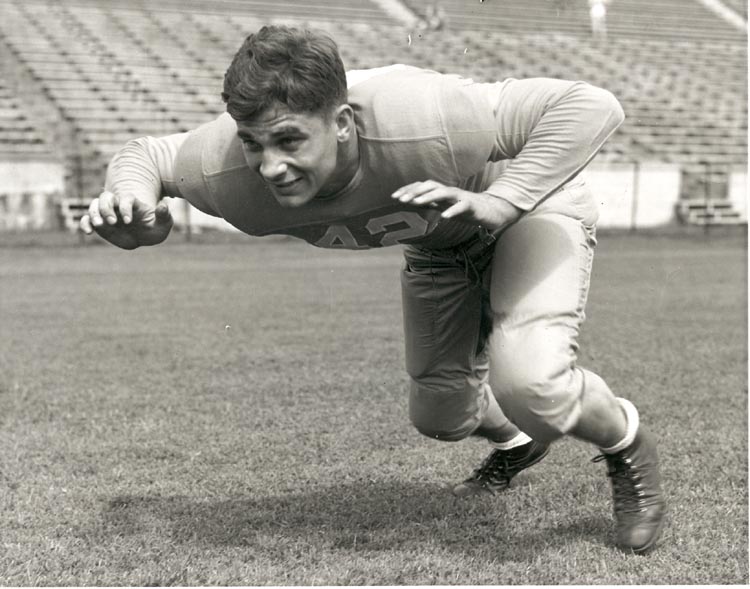Thousands of little boys from around here, blessed with little orange shirts, grew up to be followers of Tennessee football. Some learned from their parents. Some learned listening to the Vol Network.
Some saved souvenirs from their first visit to Neyland Stadium. Some had special photos on bedroom walls – John Majors, Doug Atkins, Reggie White, Peyton Manning, Al Wilson.
Some memorized jersey numbers. A few secured autographs. Some clipped newspaper stories. I’ve seen the scrapbooks.
Some matured into football players. Each season, each Knox County high school team has 40 or more athletes. Through the years, many, maybe most, dreamed of becoming Volunteers.
A steady flow graduated spring after spring. Now and then one earned a scholarship to the University of Tennessee. Over the past 112 years, coaches have awarded letters of athletic achievement to 173. They are ours. They are “from around here.”
Indeed, homegrown Volunteers are an exclusive group. A few became truly famous.
Charles Severance went to Central High School. He became a Volunteer in the mid-1950s. He was the man in the middle of the most famous defensive play in the history of Tennessee football.
“The Stop” was Severance, Wayne Grubb and Bill Majors puttin’ the pads to Heisman hero Billy Cannon of defending national champion LSU an inch or three short on a two-point attempt on Shields-Watkins Field, northeast corner, right in front of Section A, Nov. 7, 1959.
“He didn’t get across,’’ declared Severance.
“He did not cross the goal line,” said Grubb with finality.
Two-touchdown underdog Tennessee upset LSU, 14-13.
Bill Bates came from Farragut, played well for the Vols, advanced to the Dallas Cowboys and stayed to become a legend.
Robbie Franklin, gritty guard from Holston, played tough at UT, had another career as an assistant coach and another as a brilliant auctioneer.
There was a clearly marked trail from Central High to the university. Bud Sherrod became an all-American end. Ray Graves became a captain and prominent SEC coach. Harvey Robinson was awarded the impossible task of replacing Neyland.
Four Lowe brothers took the trip from Fountain City. W.O., better known as Chink, was an all-Southern guard. He played in 1914-15-16 and 19. J.G was a third-team all-American in 1925.
Ken Donahue and Ray Cannon and O.C. Lloyd were tough Bobcats who became Vols. Some think Reggie Cobb was Tennessee’s best-ever running back.
Tim Irwin became a very good Volunteer lineman and even better in a long NFL career. He is the Knox County juvenile judge and the really big man among the Chillbillies, an enthusiastic band that allegedly does rhythm, boogie and blues – with some Hank Williams just for fun.
Mack Gentry and Irwin were academic all-Americans at Tennessee.
Fulton High sent Jackie Walker to become an all-American linebacker. Ron Widby won all-America honors as a punter and basketball forward. He was less prominent in baseball and golf.
Richard Pickens and Jim McDonald were excellent representatives of Young High. Joey Clinkscales and the famous McKenzie brothers came from the East side of town. Powell provided John Bruhin and Daryle Smith. South sent Bill Young and Steve Chancey. Harold Stancell was a top name from Karns.
Remember Rule High? It sent forth Mike and Joe Cofer, Mike Price and Looney Smith.
From Webb School came Nick Reveiz, Hank Walters, Billy Arbo and, currently, Todd Kelly Jr. Bo Shafer came from West. Daniel Hood represented Catholic.
More recently, Christian Academy of Knoxville gave us Brent Kendrick and Josh Smith.
Bob Foxx (old Knoxville High) was SEC player of the year in 1939. Johnny Butler won fame with an unbelievable S-shaped 56-yard run against Alabama. Pug Vaughan was one of Neyland’s better passers. Buster Stephens led the Vols to the 1945 Rose Bowl. Cousin Ray Byrd, fast fullback, scored several Tennessee touchdowns.
Buddy Cruze of East High was an all-American end. He liked to say he made John Majors famous. Buddy caught the two decisive passes against Georgia Tech in 1956, one of college football’s greatest games.
Some became Volunteers without benefit of scholarships, without being recruited or even wanted.
As walk-ons go, J.J. McCleskey, 1989-1992, was one in a million. His mother brought him in from Karns. They waited patiently in the lobby at the athletic department until a coach was available for consultation. They met assistant Kippy Brown.
“I will never forget it. All they wanted was a chance,” said Kippy. “The mother said her son would do everything I told him to do. She said if I had any problem, to call her.”
Kippy remembers that J.J. had a problem. He was too small. But, he had the heart of a lion. He worked and worked some more. He played well as a wide receiver and defensive back. He won team awards. He became a co-captain.
After that, he went off to play in the NFL, a genuine career, eight seasons, New Orleans Saints and Arizona Cardinals.
“Nobody could have imagined J.J. McCleskey playing professional football,” said Kippy Brown. “I love underdogs.”
Roland Julian, Tom Mattingly and other keepers of the flame might tell you that Bob Suffridge (Central) was Knoxville’s most famous football player. He was Tennessee’s only three-time all-American. Neyland said Bob was the best guard he ever saw.
Neyland said other descriptive things about Suff that KnoxTNToday publisher Sandra Clark won’t let me post on her family website.
Suffridge is Knoxville’s representative in the College Football Hall of Fame.
Marvin West welcomes corrections and additions. His address is marvinwest75@gmail

